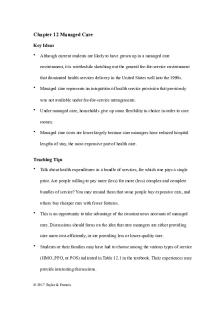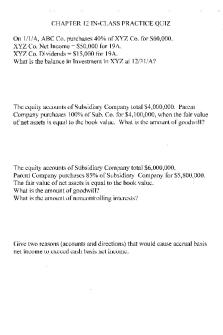Ch 12 - Practice questions on chapter 12, which really helpful before taking quiz 2. PDF

| Title | Ch 12 - Practice questions on chapter 12, which really helpful before taking quiz 2. |
|---|---|
| Course | Human Anatomy and Physiology |
| Institution | Athabasca University |
| Pages | 6 |
| File Size | 294.5 KB |
| File Type | |
| Total Downloads | 103 |
| Total Views | 156 |
Summary
Practice questions on chapter 12, which really helpful before taking quiz 2....
Description
Select a chapter:
Chapter 12 1. Nerve cell fibers are a. axons b. dendrites c. both axons and dendrites d. Nissl bodies 2. Which of the following ions pass through the resting neuronal cell membrane most easily? a. sodium b. calcium c. potassium d. phosphate 3. The cells within the nervous system that fill spaces and support neurons are collectively called a. endothelia b. Schwann cells c. neuroglia d. ependyma 4. During the absolute refractory period a. protein anions are leaving the neuron b. a high intensity stimulus can generate a new action potential c. neurotransmitters are being secreted d. Na+ channels are inactivated 5. The Nissl bodies function in a. protein production b. Ca++ storage c. insulation d. Schwann cell production
6. Retinal neurons are classified as a. multipolar b. unipolar c. bipolar d. pseudounipolar 7. When threshold of a neuron is reached, _____ is produced a. a summation b. an action potential c. a resting potential d. a graded potential 8. In myelinated nerves, the a. action potential occurs at a neurolemmocyte b. action potential occurs at each neurofibril node (node of Ranvier) c. action potential moves like a continuous wave across the cell membrane d. threshold is lower than in unmyelinated nerves 9. The autonomic nervous system is part of the a. PNS b. SNS c. CNS d. All of these 10. Which type of neuroglial cells is found supporting neuronal cell bodies within ganglia? a. astrocytes b. satellite cells c. ependymal cells d. microglia 11. Signs of multiple sclerosis usually begin a. at birth b. during the teen age years c. between the ages of 20 and 40 d. usually in later life, around 60 years of age 12. Masses of myelinated nerve fibers appear
a. white b. gray c. brown d. transparent 13. Synaptic vesicles are found within the a. Schwann cells b. axon hillock c. Nissl bodies d. synaptic end-bulbs 14. A resting nerve fiber is polarized because the concentration of a. Na+ and K+ ions is higher on the inside of the cell membrane b. Na+ and K+ ions is higher outside the cell membrane c. Na+ is higher on the inside and K+ is higher on the outside d. Na+ is higher on the outside and K+ is higher on the inside 15. Saltatory conduction a. occurs only on unmyelinated fibers b. occurs only if nodes of Ranvier are lacking c. occurs only if the myelin sheath is continuous d. occurs only on myelinated fibers 16. Sensory impulses are carried to the central nervous system by a. afferent neurons b. efferent neurons c. motor neurons d. interneurons 17. During depolarization of a neuron a. Na+ and K+ both move out of the cell b. Na+ and K+ both move into the cell c. Na+ moves into the cell d. K+ moves out of the cell 18. Autonomic nerve fibers that originate within the central nervous system and innervate the visceral organs are classified as a. somatic sensory nerves b. somatic motor nerves
c. visceral sensory nerves d. visceral motor nerves 19. a. astrocytes b. satellite cells c. ependymal cells d. microglia 20. The dendrites of a neuron a. conduct impulses toward the cell body b. secrete neurotransmitters c. conduct impulses away from the cell body d. do not carry impulses, only axons do 21. Which of the following is not a function of glial cells? a. produce myelin sheath b. participate in metabolism of neurotransmitters c. generate action potentials d. give support to neurons 22. a. All are efferent b. All are afferent c. They have several dendrites and one axon d. They have several axons and only one dendrite 23. The generation of an action potential is an electrochemical event. The electrical portion occurs a. within the neuron b. only in nerves with neurolemma c. within the myelin sheath d. in microglia 24. Which of the following is associated with ganglia? a. oligodendrocyte b. ependymal cell c. satellite cell d. Schwann cell
25. Which of the following is made up in part of neuron cell bodies? a. node of Ranvier b. Schwann cell c. myelin d. gray matter 26.
? a. Na+ enters the cell b. repolarization c. K+ enters the cell d. depolarization
27. Which of the following is characteristic of unmyelinated fibers? a. A fibers b. continuous conduction c. Schwann cells d. saltatory conduction 28. a. astrocytes b. microglia c. collaterals d. Nissl cells 29. a. sodium b. potassium c. calcium d. chloride 30. Axons of the general visceral efferent neurons that extend to autonomic ganglia are a. A fibers b. B fibers c. C fibers d. D fibers 31. At a synapse, the neuron sending the signal is called the _______ neuron
a. presynaptic b. postsynaptic c. axodendritic d. axoaxonic 32. a. depolarization b. repolarization c. EPSPs d. hyperpolarization 33. a. an IPSP b. an action potential c. an EPSP d. no change in the membrane potential 34. Curare, a poison used by South American Indians, causes muscular paralysis by a. blocking acetylcholine receptors b. blocking the release of acetylcholine c. stimulating the removal of acetylcholine d. affecting muscle contraction directly Submit
Reset...
Similar Free PDFs

Chapter 12 practice exam questions
- 13 Pages

Quiz-12-solutions - quiz 12
- 3 Pages

Chapter 12 quiz
- 12 Pages

Chapter 12 Quiz Answers
- 12 Pages

BSA 12 - helpful notes
- 3 Pages

Chapter 12 - Practice problems
- 32 Pages

Chapter 12 Practice Problems
- 6 Pages

Quiz 12 620 - quiz 12
- 5 Pages

Chapter 12 Quiz - Weekly Quiz
- 3 Pages

Chapter 12 QUIZ - MS.WONG
- 3 Pages

Chapter 12 - Quiz solution
- 12 Pages

Quiz for Chapter 12
- 9 Pages

ACC270- Chapter 12 Quiz
- 8 Pages
Popular Institutions
- Tinajero National High School - Annex
- Politeknik Caltex Riau
- Yokohama City University
- SGT University
- University of Al-Qadisiyah
- Divine Word College of Vigan
- Techniek College Rotterdam
- Universidade de Santiago
- Universiti Teknologi MARA Cawangan Johor Kampus Pasir Gudang
- Poltekkes Kemenkes Yogyakarta
- Baguio City National High School
- Colegio san marcos
- preparatoria uno
- Centro de Bachillerato Tecnológico Industrial y de Servicios No. 107
- Dalian Maritime University
- Quang Trung Secondary School
- Colegio Tecnológico en Informática
- Corporación Regional de Educación Superior
- Grupo CEDVA
- Dar Al Uloom University
- Centro de Estudios Preuniversitarios de la Universidad Nacional de Ingeniería
- 上智大学
- Aakash International School, Nuna Majara
- San Felipe Neri Catholic School
- Kang Chiao International School - New Taipei City
- Misamis Occidental National High School
- Institución Educativa Escuela Normal Juan Ladrilleros
- Kolehiyo ng Pantukan
- Batanes State College
- Instituto Continental
- Sekolah Menengah Kejuruan Kesehatan Kaltara (Tarakan)
- Colegio de La Inmaculada Concepcion - Cebu


